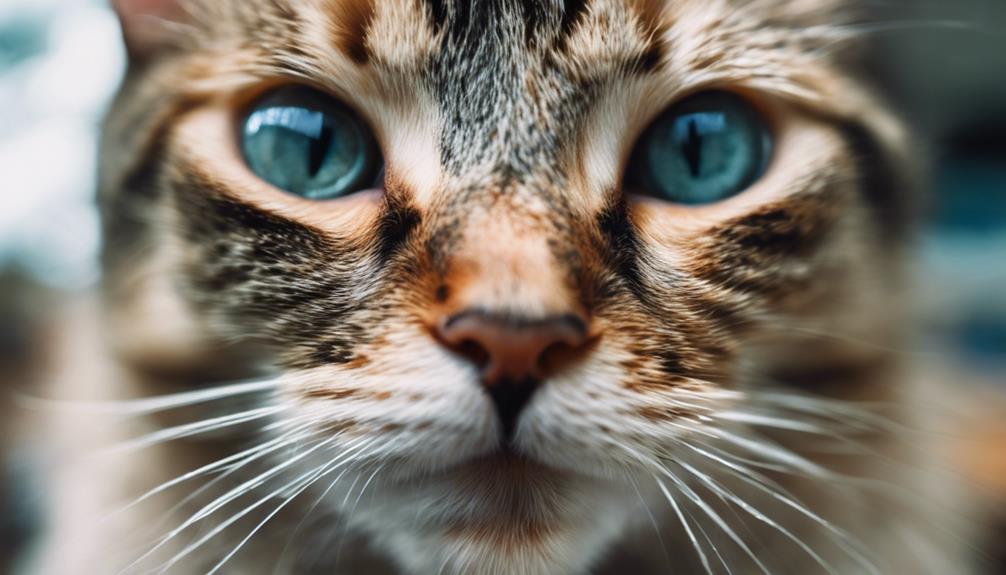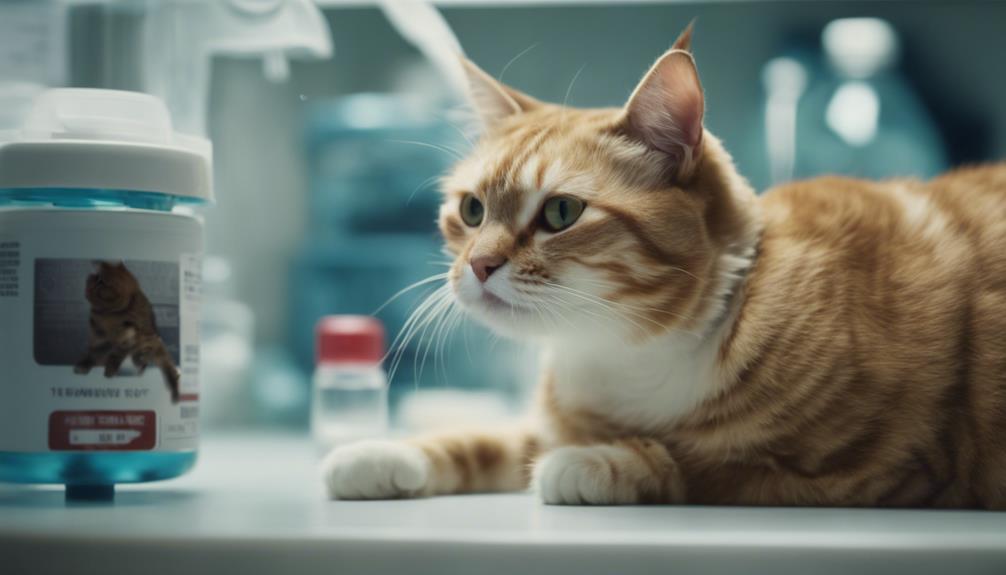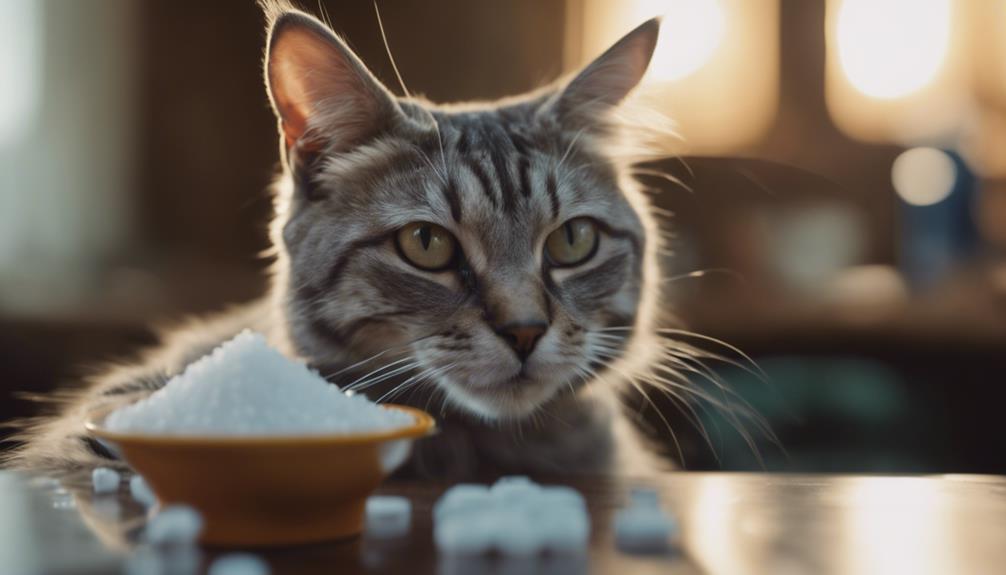In the intricate world of feline health, the role of salt in a cat's diet poses a multifaceted question that demands careful consideration.
Veterinarians, as custodians of feline well-being, offer invaluable perspectives on the complexities surrounding salt consumption in cats.
By exploring the nuances of this essential mineral's impact on our feline companions, these experts shed light on a topic that is both intricate and pivotal in ensuring optimal health for our beloved pets.
Key Takeaways
- Most cats receive adequate salt through their diet.
- Excessive salt intake can be harmful to cats.
- Symptoms of salt toxicity in cats require immediate veterinary attention.
- Treatment for salt poisoning in cats may involve IV fluids and monitoring.
Importance of Salt in Cat Nutrition
Salt plays a crucial role in ensuring proper nerve and muscle cell function in the nutritional requirements of cats. Adequate salt intake is vital for maintaining the electrolyte balance necessary for these functions. Cats, like humans, need a certain amount of sodium in their diet to support overall health.
While cats are known for their ability to regulate salt levels through their urine, it is essential to provide them with the right amount in their food. Commercial cat foods are typically formulated to meet these requirements. However, reduced-sodium diets may be recommended for cats with specific health conditions.
Monitoring your cat's salt intake is essential to prevent potential issues related to excessive or insufficient sodium levels.
Recommended Sodium Levels for Cats
A crucial aspect of feline nutrition involves maintaining appropriate levels of sodium to support essential bodily functions. In cat diets, the recommended sodium levels are carefully balanced to ensure optimal health. The table below outlines the general guidelines for sodium levels in cat food:
| Life Stage | Sodium Level |
|---|---|
| Kitten | 0.3 – 0.6% |
| Adult | 0.2 – 0.4% |
| Senior | 0.2 – 0.4% |
| Pregnant | 0.3 – 0.6% |
| Lactating | 0.3 – 0.6% |
These levels are designed to meet the specific needs of cats at different stages of life, ensuring they receive adequate sodium for proper growth and maintenance. It's essential to adhere to these recommendations to promote your cat's well-being.
Sources of Salt in Cat Diet

Incorporated within commercial cat food formulations, various ingredients naturally contribute to the salt content in a feline's diet. Meat, fish, and poultry, which are common components of cat food, naturally contain sodium. Additionally, some cat food recipes include added salt for flavor enhancement and preservation.
Treats, whether store-bought or homemade, may also contribute to a cat's salt intake. It's essential for cat owners to be mindful of the overall salt content in their feline companion's diet, considering both the main meals and any supplementary foods given.
While cats require salt for bodily functions, excessive intake can lead to health complications. Thus, understanding the various sources of salt in a cat's diet is crucial for maintaining their overall well-being.
Risks of Excessive Salt Intake
Excessive consumption of salt by cats can pose significant health risks that pet owners should be aware of to safeguard their feline companions' well-being. Cats are sensitive to salt levels, and too much salt can lead to serious complications. Here are some risks associated with excessive salt intake:
- Increased Blood Pressure: High salt intake can raise a cat's blood pressure, leading to hypertension.
- Kidney Damage: Excessive salt can strain the kidneys, potentially causing long-term damage.
- Dehydration: Salt draws water out of cells, which can result in dehydration if not properly managed.
- Electrolyte Imbalance: Too much salt can disrupt the balance of electrolytes in a cat's body, affecting various bodily functions.
Monitoring your cat's salt intake is crucial to prevent these risks and maintain their overall health and well-being.
Symptoms of Salt Toxicity in Cats

Signs indicating salt toxicity in cats manifest through observable changes in their water intake and urine volume. If your feline companion starts drinking more water than usual or producing significantly larger amounts of urine, it could be a sign of salt toxicity.
Other symptoms may include vomiting, diarrhea, lethargy, muscle weakness, seizures, and disorientation. In severe cases, salt toxicity can lead to rapid heartbeat, behavior changes, coma, and even death.
These symptoms can appear shortly after salt ingestion, requiring immediate veterinary attention. If you suspect your cat has ingested a large amount of salt or is showing any of these signs, contacting a veterinarian promptly is crucial to prevent further complications and ensure appropriate treatment.
Effects of Salt Toxicity in Cats
The detrimental impact of salt toxicity on cats encompasses a range of severe physiological effects that necessitate immediate veterinary intervention.
- Dehydration: Excessive salt intake can lead to dehydration in cats, putting strain on their organs and overall health.
- Electrolyte Imbalance: Salt toxicity disrupts the delicate balance of electrolytes in a cat's body, affecting nerve and muscle function.
- Organ Damage: Prolonged exposure to high levels of salt can cause damage to the kidneys, heart, and other vital organs.
- Neurological Issues: Salt toxicity can result in neurological symptoms such as seizures, disorientation, and even coma, posing serious risks to a cat's well-being.
These effects highlight the importance of preventing salt toxicity in cats and seeking prompt medical attention if ingestion occurs.
Recognizing Salt Toxicity in Cats

Detecting the presence of salt toxicity in cats requires vigilant observation of their behavior and physical symptoms. Cats can be sensitive to excess salt, and recognizing the signs early is crucial for prompt treatment. Below is a table summarizing common symptoms and effects of salt toxicity in cats:
| Symptoms | Effects |
|---|---|
| Changes in water intake | Rapid heartbeat |
| Vomiting | Behavior changes |
| Diarrhea | Coma |
| Muscle weakness | Death |
| Seizures |
If you notice any of these signs in your cat, contact your veterinarian immediately for guidance on the next steps to ensure your feline friend's well-being.
Treating Salt Poisoning in Cats
In addressing salt poisoning in cats, prompt and appropriate veterinary intervention is crucial for effectively managing this serious condition.
Treatment of Salt Poisoning in Cats:
- Fluid Therapy: Administering intravenous fluids helps restore hydration levels and correct electrolyte imbalances caused by salt toxicity.
- Monitoring: Regular monitoring of vital signs, electrolyte levels, and organ function is essential to track the cat's response to treatment and adjust as needed.
- Supportive Care: Providing supportive care such as anti-nausea medication, anti-seizure drugs, and other symptomatic treatments can aid in the cat's recovery.
- Hospitalization: Severe cases may require hospitalization for intensive care and continuous monitoring until the cat stabilizes.
Managing Mild Salt Poisoning

Managing Mild Salt Poisoning in cats involves closely monitoring their salt intake and providing appropriate hydration to alleviate symptoms. If you suspect your cat has consumed excess salt, offer small amounts of fresh water to dilute the salt concentration in their body.
Encourage your cat to drink water to help flush out the excess salt through urine. Monitor your cat for signs of dehydration, such as dry mouth or lethargy, and seek veterinary advice if necessary.
Mild cases of salt poisoning can often be managed at home with proper hydration and monitoring. However, if your cat shows severe symptoms like vomiting, seizures, or disorientation, immediate veterinary attention is crucial to prevent further complications.
Veterinary Treatment for Salt Toxicity
Upon suspecting salt toxicity in a cat, prompt veterinary intervention is crucial to ensure appropriate treatment and monitoring. Veterinary treatment for salt toxicity may include:
- Immediate Fluid Therapy: Administering IV fluids helps restore electrolyte balance and flush excess salt from the cat's system.
- Electrolyte Monitoring: Regular monitoring of electrolyte levels is essential to prevent complications such as dehydration or organ damage.
- Anti-Seizure Medication: In cases of seizures resulting from salt toxicity, appropriate medications may be administered to control seizures.
- Hospitalization and Observation: Close monitoring in a veterinary hospital setting allows for continuous care and timely interventions in case of any adverse effects.
Conclusion
In conclusion, the intricate balance of salt intake in a cat's diet is crucial for their overall health and well-being. By understanding the recommended sodium levels, sources of salt in their diet, and the risks associated with excessive intake, pet owners can better navigate this complex topic.
Veterinarians play a key role in educating cat owners on the importance of monitoring salt consumption to ensure optimal feline health. Remember, when it comes to salt and cats, knowledge is power.




